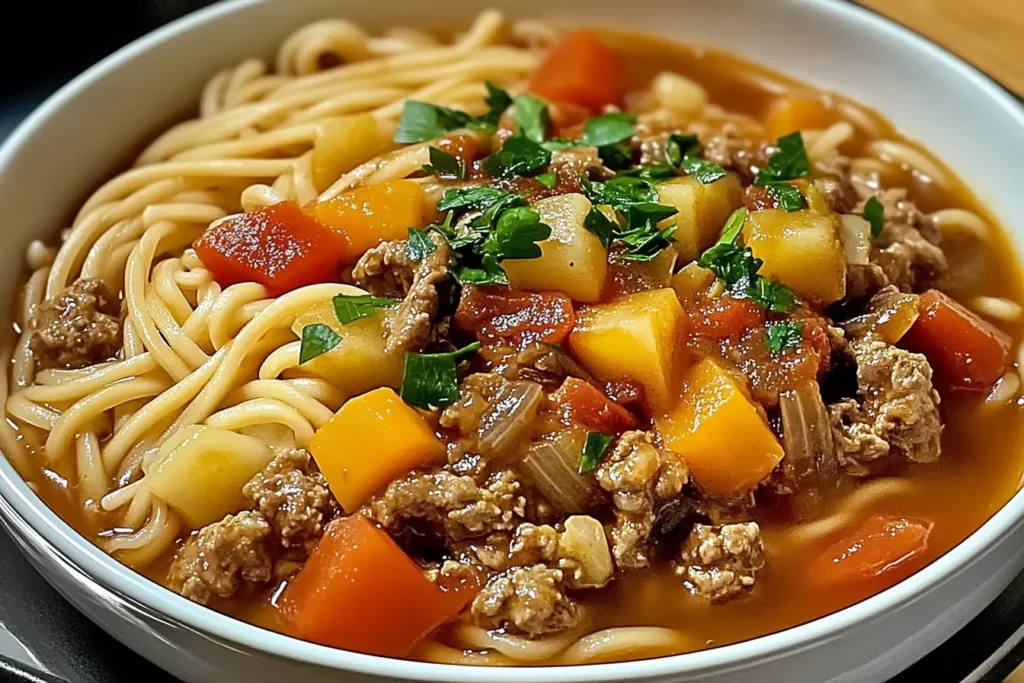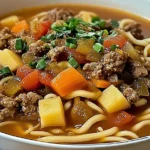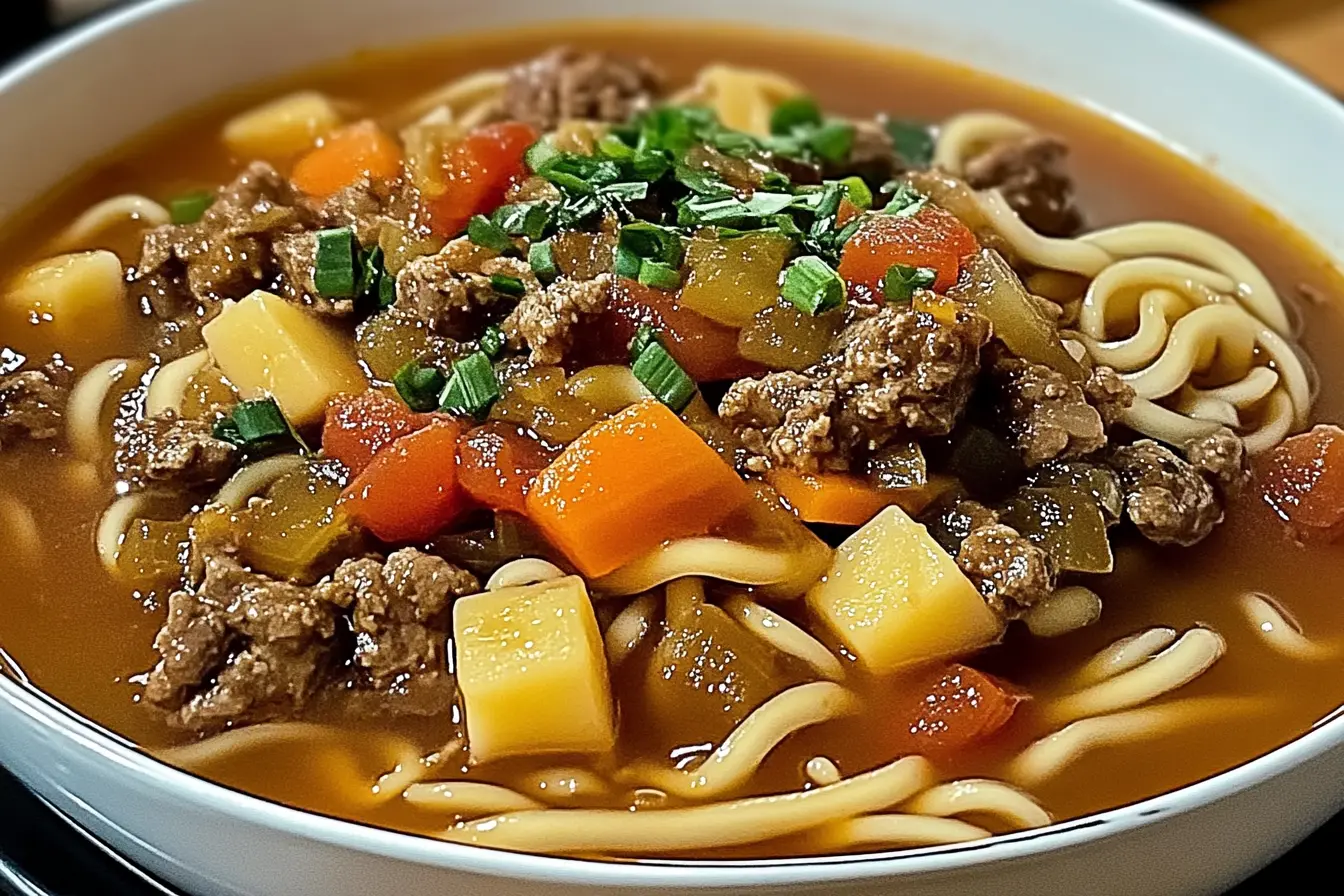Introduction
From bustling street stalls in Hanoi to cozy home kitchens worldwide, Meat and Noodle Soup embodies comfort in every spoonful. Whether you crave a soothing midday lunch or a hearty dinner, this versatile dish marries the unctuous flavors of slow-simmered meat with the satisfying chew of noodles, all swimming in a deeply flavored broth. In this article, you’ll explore its storied past, learn essential techniques, and discover countless variations to make this soup your own.
Origins & History of Meat and Noodle Soup
The genesis of Meat and Noodle Soup stretches back millennia. Early records from China describe simple noodle soups served to travelers along the Silk Road. Central Asian communities, including the Uyghur and Bukharian peoples, perfected hand-pulled noodle dishes like laghman, marrying meat, vegetables, and broth in a single pot.
By the late 19th century, Vietnamese cooks adapted Chinese noodle traditions to local tastes, giving birth to phở, an aromatic bowl of beef slices, flat rice noodles, and fragrant spices. Today, regional classics—from Japanese ramen to Korean kalguksu—trace their lineage to these pioneering recipes. For a primer on the art of building a perfect broth, see this overview of broth fundamentals.
Essential Components
Crafting an unforgettable bowl of Meat and Noodle Soup hinges on three pillars:
- Broth / Stock
- The soul of the soup: a clear, flavorful liquid that bathes every ingredient.
- Distinction: traditional broth vs. heartier stock (made with bones).
- Aromatics (onion, garlic, ginger) and spices (star anise, cinnamon) infuse depth.
- Meat
- Common choices:
- Beef shank or brisket for beef-based soups
- Pork shoulder or ribs for pork variations
- Chicken thighs or drumsticks for lighter profiles
- Look for cuts with connective tissue; they release gelatin for a luscious mouthfeel.
- Common choices:
- Noodles
- A textural counterpoint to tender meat:
- Egg noodles, rice noodles, wheat noodles, hand-pulled lamian
- Fresh vs. dried: fresh cooks faster, but dries store
- Cooking method affects texture, rinse or toss in broth, depending on preference
- A textural counterpoint to tender meat:
Ingredients You’ll Need
Gather these core components before you begin:
- Bones & Meat:
- 2 pounds beef knuckles or oxtail (for beef broth)
- Or 2–3 pounds bone-in chicken pieces (thighs or drumsticks)
- Noodles:
- 12 ounces of rice noodles (for pho)
- Or 12 ounces of egg noodles (for Western style)
- Aromatics & Seasonings:
- 1 large onion, halved and charred
- 4-inch piece of ginger, sliced and charred
- 4-star anise pods
- 1 cinnamon stick
- 4 cloves
- 1 tablespoon coriander seeds
- 2 teaspoons salt (adjust to taste)
- 1 tablespoon fish sauce (optional, for umami boost)
- Garnishes & Add-Ins:
- Fresh herbs: cilantro, Thai basil, mint
- Sliced chili peppers or jalapeños
- Lime wedges
- Bean sprouts
- Thinly sliced onion or scallions

For a deeper dive into noodle styles and origins, explore noodle varieties.
Step-by-Step Cooking Process
1. Preparing the Broth
- Blanching: Parboil bones or meat pieces 2–3 minutes to draw out scum; discard the first water.
- Aromatics & Flavor Base:
- Sauté halved onions, smashed garlic cloves, and sliced ginger until fragrant.
- Add whole spices: star anise, cinnamon stick, cloves.
- Simmering:
- Combine blanched bones/meat with aromatics and cold water.
- Bring to a gentle boil, then reduce to a simmer.
- Skim foam frequently for clarity.
2. Seasoning & Refining
- Timing:
- Bone broth: 3–4 hours for maximum gelatin extraction
- Meat-only broths: 1–2 hours for tender meat pieces
- Seasoning Agents:
- Salt and white pepper to taste
- Soy sauce, fish sauce, or miso for umami complexity
- Finishing Touches:
- A splash of rice vinegar or lime juice brightens the broth.
- Fresh herbs added just before serving preserve aroma.
3. Cooking the Noodles
- Separate Pot Method:
- Boil noodles in a dedicated pot for 1–3 minutes (depending on type).
- Drain, rinse under cool water to stop cooking, then portion into bowls.
- In-Broth Method:
- Add dried noodles directly to simmering broth 2–4 minutes before serving.
- Note: may cloud the broth and absorb seasonings.
4. Assembling the Bowl
- Place noodles at the bottom of warmed bowls.
- Arrange sliced meat (shredded chicken, thinly sliced beef) atop noodles.
- Ladle piping-hot broth over, submerging ingredients.
- Garnish generously:
- Fresh herbs (cilantro, Thai basil, scallions)
- Thinly sliced chilies or chili oil
- Lime wedges for acidity
Regional & Culinary Variations
East Asia
- Vietnamese Phở: flat rice noodles, beef brisket, charred onion, and star-anise-laced broth.
- Japanese Ramen: wavy wheat noodles, pork chashu, nori, and rich tonkotsu or shoyu broth.
- Korean Kalguksu: homemade knife-cut wheat noodles in a light seafood or chicken broth.
Central Asia
- Bukharian Laghman: hand-pulled noodles topped with stir-fried meat and vegetables in a savory sauce.
- Uyghur Laghman: features thicker noodles, lamb, bell peppers, tomatoes, and cumin.
Western Hybrids
- French-Inspired Beef Noodle Soup: slow-cooked beef, pearl onions, and tarragon in a clear consommé.
- Fusion Creations: pho tacos, ramen burgers, and other inventive takes that blend cultures.
Serving Suggestions & Pairings
Elevate your Meat and Noodle Soup experience with complementary sides:
- Garnishes:
- Fresh herbs: cilantro, Thai basil, mint
- Aromatics: thinly sliced scallions, minced garlic crisps
- Acid: lime or lemon wedges
- Side Dishes:
- Steamed or pan-fried buns (bao)
- Crispy spring rolls or gyoza
- Crusty bread for dipping
Make-Ahead, Storage & Reheating
To enjoy this soup on busy days:
- Storage:
- Keep broth separate from noodles and garnishes in airtight containers.
- Refrigerate broth for up to 4 days; freeze for up to 3 months.
- Reheating:
- Broth: Slowly reheat on the stovetop to preserve clarity.
- Assembled Bowl: Pour hot broth over room-temperature noodles and toppings just before serving.
- Microwave: acceptable for broth-only portions; avoid microwaving noodles to prevent texture loss.

FAQs
- What meat cuts yield the richest broth?
- Cuts with marrow bones (beef shank, oxtail) or collagen-rich connective tissue (chicken feet, pork hocks) create a velvety mouthfeel.
- Can I substitute dried noodles for fresh?
- Yes. Increase cooking time by 1–2 minutes and adjust seasoning, as dried noodles absorb more liquid.
- How do I thicken a thin broth?
- Simmer uncovered to concentrate flavors or whisk in a small slurry of cornstarch and cold water.
- What’s the best way to reheat assembled soup?
- Always reheat broth separately; then assemble fresh with noodles and toppings to maintain texture.
- Are there vegetarian alternatives to meat stock?
- Use mushroom and seaweed-based stocks for deep umami, coupled with soy or tamari for additional richness.
Final Thoughts
Crafting the perfect noodle soup with meat is an art, and now you have the blueprint to create a bowl that’s deeply flavorful, endlessly adaptable, and thoroughly satisfying. From the initial char of aromatics to the final squeeze of lime, each step layers complexity and comfort. Next time you crave a meal that warms from the inside out, remember this guide and gather your friends or family around steaming bowls of homemade bliss.
Print
Meat and Noodle Soup
- Total Time: 1 hour
- Yield: 6 servings 1x
- Diet: Gluten Free
Description
Meat and Noodle Soup is a warm, savory soup filled with tender chunks of meat, hearty egg noodles, and vegetables simmered in a flavorful broth. Whether made with beef, pork, or chicken, it’s an easy, rustic dish perfect for chilly nights or anytime comfort food.
Ingredients
- 1 tablespoon olive oil or butter
- 1 lb stew meat (beef, pork, or chicken thighs), cut into bite-sized pieces
- Salt and pepper, to taste
- 1 small onion, diced
- 2 cloves garlic, minced
- 2 carrots, sliced
- 2 celery stalks, sliced
- 6 cups beef, chicken, or vegetable broth
- 1 teaspoon dried thyme or Italian seasoning
- 2 bay leaves
- 6 oz egg noodles or wide pasta
- Optional garnish: fresh parsley or grated Parmesan
Instructions
1. Brown the Meat
- Heat oil in a large soup pot or Dutch oven over medium heat.
- Season meat with salt and pepper, then brown in batches until seared on all sides. Remove and set aside.
2. Sauté Vegetables
- In the same pot, add onion, carrots, and celery. Cook for 5–6 minutes, stirring occasionally.
- Add garlic and cook for another 30 seconds.
3. Simmer the Broth
- Return meat to the pot.
- Pour in broth, add thyme and bay leaves. Bring to a boil, then reduce heat.
- Cover and simmer for 25–30 minutes, until meat is tender.
4. Cook the Noodles
- Add egg noodles and simmer uncovered for 8–10 minutes until tender.
- Adjust salt and pepper to taste. Remove bay leaves.
5. Serve
- Ladle into bowls and garnish with fresh parsley or Parmesan if desired.
- Prep Time: 15 minutes
- Cook Time: 45 minutes
- Category: Soup Recipes
- Method: Stovetop Simmered
- Cuisine: American
Nutrition
- Serving Size: 1½ cups per person
- Calories: 350 kcal
- Sodium: 620 mg
- Fat: 14 g
- Saturated Fat: 4 g
- Trans Fat: 0 g
- Carbohydrates: 30 g
- Fiber: 3 g
- Protein: 28 g
- Cholesterol: 75 mg
Keywords: Meat and Noodle Soup

